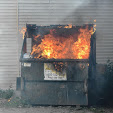 |
| On the left, some of the lumens. On the right, all of the lumens. Photo courtesy of Pat Rogers/EAG Tactical. |
Since the OWB holster I had was a Raven Phantom for the TLR-1S, I moved the slide from the Tactical Dirt Color gun onto that frame (no backup irons on the DeltaPoint
I'm glad I switched.
See, the CTC Lightguard
If I'm pulling my gun out and pointing it at something, it's generally because I've already identified it as a threat. Sure, it's possible to dream up scenarios where a light on a CCW handgun, especially one with a grip-activated switch, could be a detriment ("Suppose you're in a store and terrorists cut the power and you want to pull out your gun but not give away your position? And maybe ninjas!") but most of them are so far outside the likely uses of my CCW gun that I have yet to be persuaded that being able to better see my target is a bad thing.
Proper use of a pistol-mounted light is something very few non-cops (and too few LEOs) ever get taught. I certainly don't have much knowledge of it, and what I have is mostly theoretical, gleaned from keeping my ears open when smarter people are talking.
One thing I do know is that for that application, more lumens are generally better lumens. In the picture at the top of this post, that's my gun light on the left: A TLR-1s
That pattern part is important. See the light on the right in that top picture? That's the current industry standard, the "U-Boat", a Surefire X300U
The picture at the top illustrates another point: How long an "indoors" shot can be. That one looks close to twenty yards right there, and if you look around hallways at work, down the aisles at the store, and corridors at your church or other public buildings, you'll quickly come to realize that "Indoors" does not equal "In the same broom closet."
More on this class to come...
.



